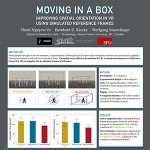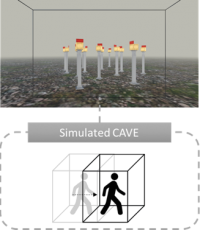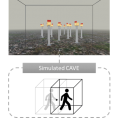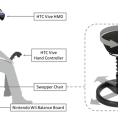Navigational Search in VR: Do Reference Frames Help?
Would the rectangular reference frame of a CAVE help to reduce disorientation and improve navigation performance in VR? Here, we show that simply providing the rectangular reference frame of a room (as a simple wireframe cuboid), but not a CAVE improved navigational search performance.
Despite recent advances in virtual reality, locomotion in a virtual environment is still restricted because of spatial disorientation. Previous research has shown the benefits of reference frames in maintaining spatial orientation. Here, we propose using a visually simulated reference frame in virtual reality to provide users with a better sense of direction in landmark-free virtual environments. Visually overlaid rectangular frames simulate different variations of frames of reference. We investigated how two different types of visually simulated reference frames might benefit in a navigational search task through a mixed-method study. Results showed that the presence of a reference frame significantly affects participants’ performance in a navigational search task. Though the egocentric frame of reference (simulated CAVE) that translates with the observer did not significantly help, an allocentric frame of reference (a simulated stationary room) significantly improved user performance both in navigational search time and overall travel distance. Our study suggests that adding a variation of the reference frame to virtual reality applications might be a cost-effective solution to enable more effective locomotion in virtual reality.
For more information and to download a demo, see http://navisearch.ispacelab.com/

http://ispace.iat.sfu.ca/wp-content/plugins/zotpress/
apa
37904
Nguyen-Vo, T., Riecke, B. E., & Stuerzlinger, W. (2017). Moving in a Box: Improving Spatial Orientation in Virtual Reality using Simulated Reference Frames. 207–208. https://doi.org/10.1109/3DUI.2017.7893344

Click to view Poster
Media Gallery
Publications
http://ispace.iat.sfu.ca/wp-content/plugins/zotpress/
37904
Nguyen-Vo, Thinh, Bernhard E. Riecke, and Wolfgang Stuerzlinger. 2017. “Investigating the Effect of Simulated Reference Frames on Spatial Orientation in Virtual Reality.” Poster presented at the Second International Workshop on Models and Representations in Spatial Cognition, Tübingen, Germany, April 6.
(Download)
37904
Adhikari, Ashu, Bernhard E. Riecke, Abraham M. Hashemian, Thinh Nguyen-Vo, Ernst Kruijff, and Markus von der Heyde. 2021. “Embodied VR Flying Improves Spatial Orientation While Reducing Cybersickness.” Talk presented at the ICSC 2021: 8
th International Conference on Spatial Cognition, Rome, Italy.
https://youtu.be/FbmE4SEISWU.
(Download)
37904
Hashemian, Abraham M., Alexandra Kitson, Thinh Nguyen-Vo, Hrvoje Benko, Wolfgang Stuerzlinger, and Bernhard E. Riecke. 2018. “Investigating a Sparse Peripheral Display in a Head-Mounted Display for VR Locomotion.” In
2018 IEEE Conference on Virtual Reality and 3D User Interfaces (VR), 571–72. Reutlingen, Germany: IEEE. https://doi.org/10.1109/VR.2018.8446345.
(Download)
37904
Nguyen-Vo, Thinh, Bernhard E. Riecke, and Wolfgang Stuerzlinger. 2018. “Simulated Reference Frame: A Cost-Effective Solution to Improve Spatial Orientation in VR.”
2018 IEEE Conference on Virtual Reality and 3D User Interfaces (VR) (Reutlingen, Germany), 415–22. https://doi.org/10.1109/VR.2018.8446383.
(Download)
37904
Nguyen-Vo, Thinh, Bernhard E. Riecke, Wolfgang Stuerzlinger, Duc-Minh Pham, and Ernst Kruijff. 2018. “Do We Need Actual Walking in VR? Leaning with Actual Rotation Might Suffice for Efficient Locomotion.” Poster presented at the Spatial Cognition 2018.
(Download)
37904
Nguyen-Vo, T., Riecke, B. E., & Stuerzlinger, W. (2017).
Moving in a Box: Improving Spatial Orientation in Virtual Reality using Simulated Reference Frames. 207–208. https://doi.org/10.1109/3DUI.2017.7893344
(Download)





